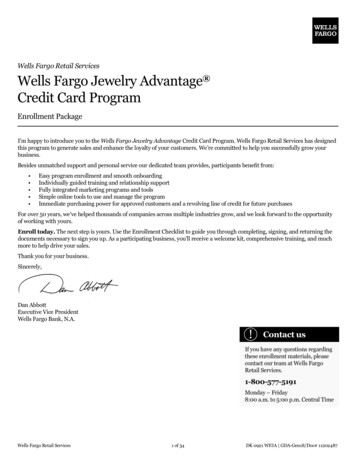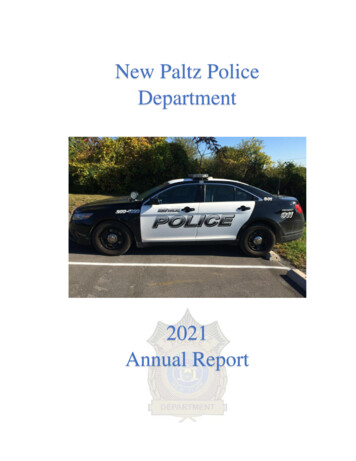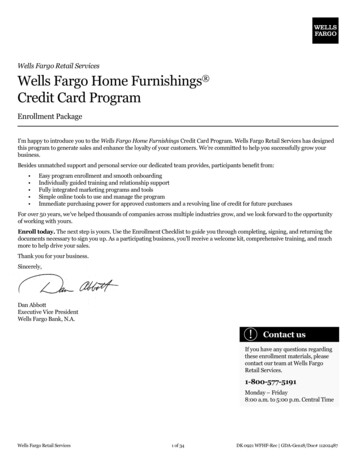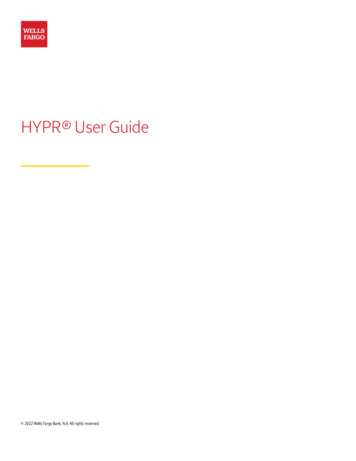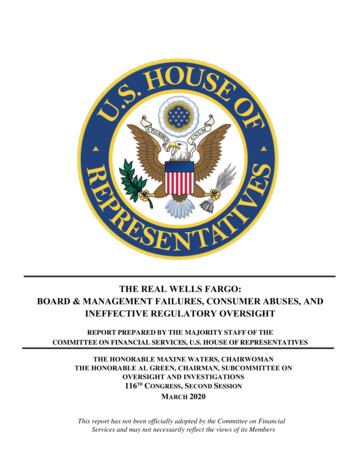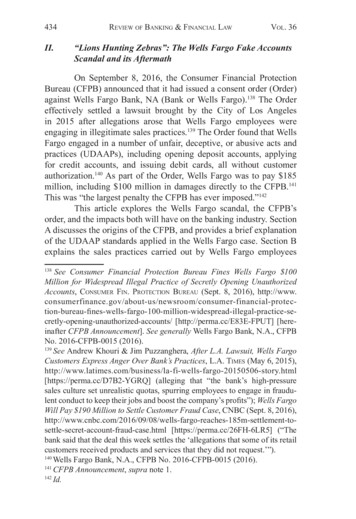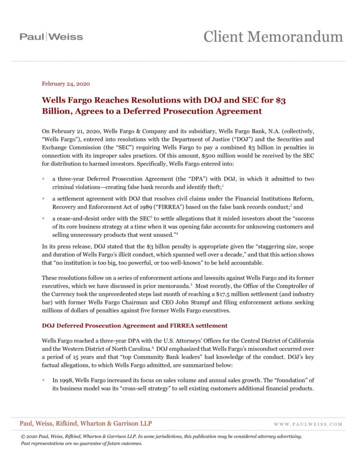
Transcription
February 24, 2020Wells Fargo Reaches Resolutions with DOJ and SEC for 3Billion, Agrees to a Deferred Prosecution AgreementOn February 21, 2020, Wells Fargo & Company and its subsidiary, Wells Fargo Bank, N.A. (collectively,“Wells Fargo”), entered into resolutions with the Department of Justice (“DOJ”) and the Securities andExchange Commission (the “SEC”) requiring Wells Fargo to pay a combined 3 billion in penalties inconnection with its improper sales practices. Of this amount, 500 million would be received by the SECfor distribution to harmed investors. Specifically, Wells Fargo entered into: a three-year Deferred Prosecution Agreement (the “DPA”) with DOJ, in which it admitted to twocriminal violations—creating false bank records and identify theft;1 a settlement agreement with DOJ that resolves civil claims under the Financial Institutions Reform,Recovery and Enforcement Act of 1989 (“FIRREA”) based on the false bank records conduct;2 and a cease-and-desist order with the SEC3 to settle allegations that it misled investors about the “successof its core business strategy at a time when it was opening fake accounts for unknowing customers andselling unnecessary products that went unused.”4In its press release, DOJ stated that the 3 billon penalty is appropriate given the “staggering size, scopeand duration of Wells Fargo’s illicit conduct, which spanned well over a decade,” and that this action showsthat “no institution is too big, too powerful, or too well-known” to be held accountable.These resolutions follow on a series of enforcement actions and lawsuits against Wells Fargo and its formerexecutives, which we have discussed in prior memoranda. 5 Most recently, the Office of the Comptroller ofthe Currency took the unprecedented steps last month of reaching a 17.5 million settlement (and industrybar) with former Wells Fargo Chairman and CEO John Stumpf and filing enforcement actions seekingmillions of dollars of penalties against five former Wells Fargo executives.DOJ Deferred Prosecution Agreement and FIRREA settlementWells Fargo reached a three-year DPA with the U.S. Attorneys’ Offices for the Central District of Californiaand the Western District of North Carolina.6 DOJ emphasized that Wells Fargo’s misconduct occurred overa period of 15 years and that “top Community Bank leaders” had knowledge of the conduct. DOJ’s keyfactual allegations, to which Wells Fargo admitted, are summarized below: In 1998, Wells Fargo increased its focus on sales volume and annual sales growth. The “foundation” ofits business model was its “cross-sell strategy” to sell existing customers additional financial products. 2020 Paul, Weiss, Rifkind, Wharton & Garrison LLP. In some jurisdictions, this publication may be considered attorney advertising.Past representations are no guarantee of future outcomes.
In contrast to its public statements and disclosures about selling based on customers’ “needs,” theCommunity Bank implemented a model in which employees were directed and pressured to sell largevolumes of products to existing customers, often with little regard to actual customer need or expecteduse. This business model led thousands of its employees to engage in unlawful conduct, including fraud,identity theft, and the falsification of bank records. Many of these practices were referred to within Wells Fargo as “gaming,” including using existingcustomers’ identities, without their consent, to open checking and savings, debit card, credit card, billpay, and global remittance accounts. From 2002 to 2016, gaming practices included forging customersignatures to open accounts without authorization, creating PINs to activate unauthorized debit cards,and moving money from millions of customer accounts to unauthorized accounts (in a practice knownas “simulated funding”). Also, employees would alter customers’ true account information to preventcustomers from learning of unauthorized accounts and prevent Wells Fargo from reaching customersto conduct customer satisfaction surveys. The top managers of the Community Bank were aware of these practices as early as 2002 and knew thatthe conduct was increasing due to onerous sales goals. One internal investigation in 2004 called theproblem a “growing plague,” and another investigator in 2005 said the problem was “spiralling out ofcontrol.” Complaints and objections about the sales goals were regularly made to Community Bank’sleadership. Despite knowledge of the illegal sales practices, Community Bank senior leadership failedto take sufficient action. Instead, they minimized the problems to Wells Fargo management and itsboard of directors, by casting the problem as one of individual misconduct instead of one involving thesales model itself. Wells Fargo admitted that it collected millions of dollars in fees and interest to which it was not entitled,harmed the credit ratings of certain customers, and unlawfully misused customers’ sensitive personalinformation, including customers’ means of identification. 7DOJ stated that its decision to enter into the DPA took into account a number of factors, including the longduration of the improper sales practices and the role of certain “Wells Fargo senior leaders in causingand/or allowing the conduct to occur”; Wells Fargo’s extensive cooperation (including assisting DOJ in“complex data analytics projects”) and its continuing cooperation in the investigations; its admission ofwrongdoing; its prior regulatory and civil settlements, including ongoing consent orders; and its remedialactions, including “significant changes in Wells Fargo’s management and its board of directors, andenhanced compliance program, and significant work to identify and compensate customers who may havebeen victims.”8As is standard, the DPA does not preclude DOJ from investigating or prosecuting past or present WellsFargo officers or employees. News reports last month stated that multiple former Wells Fargo executiveswere under DOJ criminal investigation.92
Wells Fargo’s FIRREA settlement was reached with DOJ’s Civil Division (Commercial Litigation Branch)and the U.S. Attorney’s Office for the Central District of California. The settlement agreement adds no newfactual allegations.SEC OrderAccording to the SEC, its order arises out of a “fraud committed by Wells Fargo from 2012 through 2016,when the Company misled investors regarding the success of the core business strategy of the CommunityBank operating segment, its largest business unit.” The SEC concluded that Wells Fargo violated Section10(b) of the Securities Exchange Act of 1934 (the “Exchange Act”) and Rule 10b-5 based on the followingallegations, among others: In its annual reports and quarterly and annual filings with the SEC during this period, Wells Fargopublished a Community Bank “cross-sell metric” that it defined as the ratio of the number of accountsand products per retail bank household. In contrast to Wells Fargo’s public statements and disclosures that its sales strategy was “needs-based,”the Community Bank implemented a volume-based sales model in which employees were directed andpressured to sell large volumes of products to existing customers. This sales model led to widespread unlawful and unethical misconduct between 2002 and 2016, as iteffectively encouraged employees to engage in “gaming” conduct and to cause or persuade customersto receive unnecessary accounts. Wells Fargo failed to disclose to investors that it had opened or soldmillions of accounts and financial products that were unauthorized or fraudulent, and that the publiclyreported cross-sell metric included significant numbers of such unused or unauthorized accounts,which also rendered its investor disclosures regarding needs-based selling misleading. During its investor presentations and analyst conferences, Wells Fargo characterized its cross-sellstrategy as a key component of its business model and its ability to grow revenue and earnings, and itreferred to the cross-sell metric as proof of its success at executing on this core business strategy. Inmore than one instance, it responded to direct questions about the cross-sell metric with incompleteand misleading answers. In a January 12, 2015 response to an SEC comment letter that asked how the cross-sell metric wascalculated (and in its 2014 and 2015 annual reports), Wells Fargo provided a misleading description ofthe metric and the extent to which accounts and products were “used” by its customers. The SEC foundthat the inclusion of the word “used” was misleading, as Community Bank executives knew that themetric included many products that in fact were not used by customers. Certain Community Bank senior executives who reviewed or approved the disclosures knew, or werereckless in not knowing, that disclosures regarding its purported needs-based selling model weremisleading or incomplete.3
Community Bank senior leadership and others considered releasing an alternative metric that wouldcapture products that had been used. In developing this “active cross-sell” metric, Community Banksenior leadership recognized that as many as 10 percent of accounts included in the cross-sell metrichad not been used within the previous 12 months, but they ultimately concluded that its release wouldcause investors to raise questions about Wells Fargo’s historical sales practices.Wells Fargo agreed to cease and desist from committing or causing any future violations of the antifraudprovisions of the Exchange Act, and to pay a 500 million civil money penalty that will be deposited into aFair Fund pursuant to Section 308(a) of the Sarbanes-Oxley Act of 2002 for distribution to harmedinvestors.ImplicationsThese DOJ and SEC resolutions are further illustration that a range of federal agencies have felt justified intaking aggressive and punitive action against Wells Fargo and its former executives in light of the size, scale,and nature of the conduct involved. This action shows DOJ’s willingness, at least in circumstances it judgessufficiently serious and unique, to pursue a criminal resolution for conduct that has normally been treatedcivilly under the rubric of consumer protection violations. DOJ has also shown its continued readiness todeploy its broad civil authority under FIRREA in enforcement actions against banks. The SEC, for its part,has also sent a strong signal that financial results that are based on misleading sales metrics and consumerprotection violations can form the basis of a securities fraud action.In prior memoranda, we have discussed various “lessons learned” emerging from the fake accounts scandal,including suggestions for strengthening board and management reporting and oversight, control functions,institutional culture, and sales practices and incentive compensation controls.10 We look forward toproviding further updates on this topic.**4*
This memorandum is not intended to provide legal advice, and no legal or business decision should be basedon its content. Questions concerning issues addressed in this memorandum should be directed to:Mark S. Bergman 44-20-7367-1601mbergman@paulweiss.comSusanna M. Buergel 1-212-373-3553sbuergel@paulweiss.comJessica S. Carey 1-212-373-3566jcarey@paulweiss.comMichael E. Gertzman 1-212-373-3281mgertzman@paulweiss.comRoberto J. Gonzalez 1-202-223-7316rgonzalez@paulweiss.comBrad S. Karp 1-212-373-3316bkarp@paulweiss.comElizabeth M. Sacksteder 1-212-373-3505esacksteder@paulweiss.comAssociate Sofía D. Martos contributed to this Client Memorandum.1See Department of Justice, Wells Fargo Agrees to Pay 3 Billion to Resolve Criminal and Civil Investigations into SalesPractices Involving the Opening of Millions of Accounts without Customer Authorization (Feb. 21, 2020), available here; andDeferred Prosecution Agreement Between the United States Attorney’s Office for the Central District of California and theUnited States Attorney’s Office for the Western District of North Carolina, and Wells Fargo & Co. and Wells Fargo Bank, N.A.(Feb. 20, 2020), available here. The Statement of Facts appears as Exhibit A to the Deferred Prosecution Agreement.2Settlement Agreement Between (a) the United States of America, acting through the Civil Division of the DOJ and theAttorney’s Office for the Central District of California, and (b) Wells Fargo & Co. and Wells Fargo Bank, N.A. (Feb. 20, 2020),available here.3Securities and Exchange Commission, Order Instituting Cease-and-Desist Proceedings Pursuant to Section 21C of theSecurities Exchange Act of 1934, Making Findings, and Imposing a Cease-and-Desist Order, In the Matter of Wells Fargo &Company (Feb. 21, 2020), available here.4Securities and Exchange Commission, Press Release, Wells Fargo to Pay 500 Million for Misleading Investors About theSuccess of Its Largest Business Unit (Feb. 21, 2020), available here.5See, e.g., Paul, Weiss Client Memorandum, “OCC Takes Unprecedented Enforcement Actions Against Eight Former WellsFargo Executives, Including the Former Chairman & CEO, Head of the Bank, General Counsel, and Risk and Audit Executives”(Jan 28, 2020), available here; Paul, Weiss Client Memorandum, “Implications of the Federal Reserve’s Enforcement ActionAgainst Wells Fargo” (Feb. 12, 2018), available here; Paul, Weiss Client Memorandum, “The OCC Issues ‘Lessons Learned’Review of Its Supervision of Sales Practices at Wells Fargo” (Apr. 21, 2017), available here; Paul, Weiss Client Memorandum,“Lessons Learned from the Wells Fargo Sales Practices Investigation Report” (Apr. 18, 2017), available here; and Paul, Weiss5
Client Memorandum, “Bulk of Wells Fargo Shareholder Derivative Suit Survives Motions to Dismiss” (Dec. 4, 2017), availablehere.6DOJ noted investigative assistance by the FBI and the inspectors general of the FDIC, the FFHA, and the Federal Reserve.7The DOJ’s statement of facts also contained allegations about the bank’s disclosure of cross-sell statistics and other statementsto the investing public. These allegations are described in the SEC section below.8DOJ also made a reference to its anti-“piling on” policy: “The global settlement also reflects coordination between theDepartment of Justice and the SEC to ensure a resolution that appropriately addresses the severity of the defendants’ conductwhile avoiding the imposition of fines and penalties that are unnecessarily duplicative.”9See Kevin Wack, “Former Wells Fargo execs may face criminal charges in coming weeks,” American Banker (Jan. 3, 2020),available here.10See supra footnote 5. For additional risk-mitigation considerations, see Paul, Weiss Client Memorandum, “IncreasingRegulatory Focus on Reforming Financial Institution Culture and Addressing Employee Misconduct Risk” (Feb. 21,2018), available here.6
Wells Fargo Reaches Resolutions with DOJ and SEC for 3 Billion, Agrees to a Deferred Prosecution Agreement . of its core business strategy at a time when it was opening fake accounts for unknowing customers and . to open checking and savings, debit card, credit card, bill pay, and global remittance accounts. From 2002 to 2016, gaming .
